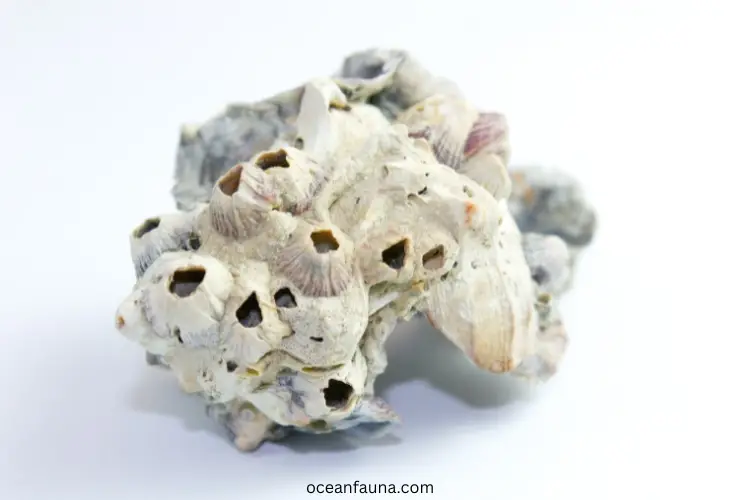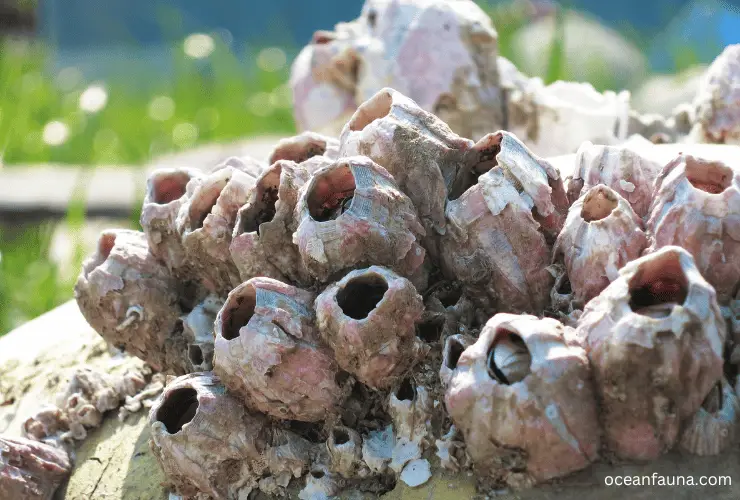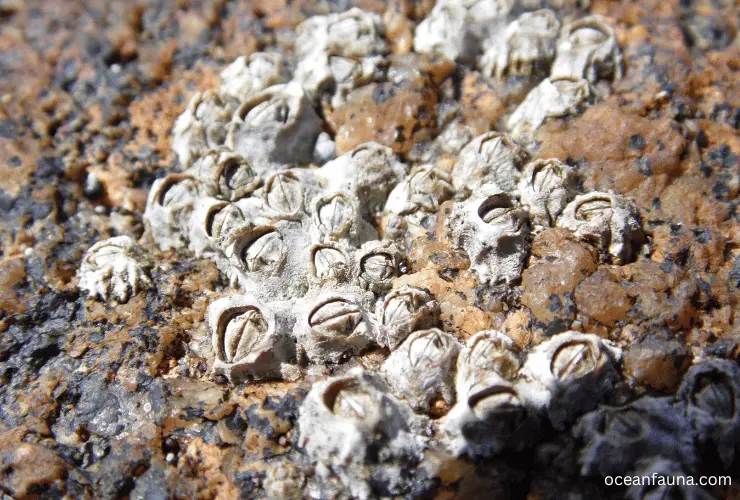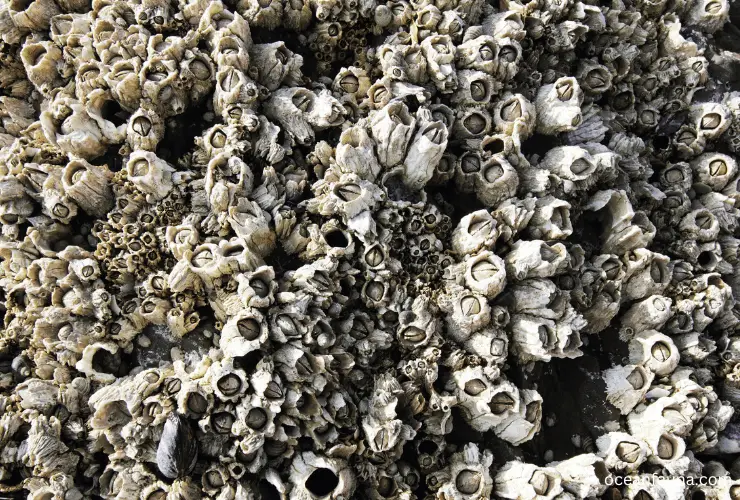Barnacles are filter feeders, meaning they strain food from the surrounding water. They primarily feed on plankton—tiny organisms as well as detritus (decomposed organic matter). Barnacles also consume algae and bacteria.
Now, you might have a question regarding how they catch their food and what kind of digestive system they have. Don’t worry. In this article, I will explain everything in detail.
What Do Barnacles Eat?
As said before, the primary food source for barnacles is plankton, tiny organisms that are also an essential component of marine food webs.
In addition to plankton, barnacles also consume detritus, which refers to decomposed organic matter that has settled on the bottom of the ocean floor. This means that barnacles play a significant role in the recycling of nutrients in marine ecosystems.
Furthermore, barnacles are known to consume algae and bacteria. Algae are essential photosynthetic organisms found in marine environments, while bacteria are microscopic single-celled organisms that play vital roles in biochemical processes.
Therefore, barnacles also help control the population of these microorganisms, balancing the ecological dynamics of marine habitats.
Do Barnacles Feed on Their Host?

While not all barnacles feed on their host, certain species of barnacles are parasitic and rely on their hosts for sustenance. These parasitic barnacles have a simpler anatomy than their free-living counterparts, lacking a carapace and limbs and only a sac-like body.
To feed, parasitic barnacles extend thread-like rhizomes of living cells into their hosts’ bodies from their points of attachment. These rhizomes allow the barnacles to extract nutrients and other vital resources from their hosts, ultimately allowing them to thrive and reproduce.
Also Read: What Do Barnacles Do? [Are They Harmful?]
Parasitic barnacles can harm their hosts by weakening or killing them, and some types can infect and feed on more than one host species. Although not all barnacles are parasitic, the impact of those can be significant to their ecosystem.
How Does Barnacle Catch Their Prey?
Barnacles stand out from other marine invertebrates because of their distinct feeding method. They employ their cirri, which are feather-like organs that comb the water for tiny organisms, to capture their prey.
Additionally, barnacles utilize their cirri to scrape off food particles from hard surfaces like rocks. The cirri rapidly extend and retract through the opening at the top of the barnacle, creating a current that carries plankton and other small organisms toward the cirri.
As the water flows through the barnacle shell, the tiny hairs on the cirri catch the prey and guide it into the barnacle’s mouth. The movement of the cirri is controlled by powerful muscles and is coordinated by a complex nervous system.
Barnacles collect and consume tiny food particles like plankton and detritus underwater. They do this by rhythmically opening and closing their “trap doors” and using cirri to gather and sweep in the food.
Barnacles are also very sensitive to their environment and can quickly detect when a potential threat is nearby. If they sense danger, they will retract their cirri and close their operculum, a protective plate that covers their shell’s opening, shielding them from predators or unfavorable conditions.
Interestingly, different species of barnacles have adapted to different environments and have developed unique strategies for catching their prey.
For example, some barnacles that live in high-energy environments, like the intertidal zone, have shorter and sturdier cirri that are better able to withstand strong currents and wave action.
How To Do Barnacle Digest: Digestive System of Barnacles
Barnacles have a unique digestive system that allows them to efficiently process their food.
Once the barnacle captures food in its cirri, which are feathery appendages that protrude from its body, they curl them down and push the captured food into its mouth. The food is then processed through several digestive organs, including the esophagus, stomach, small intestine, and anus.

The esophagus of the barnacle acts as a transport tube, moving the food from the mouth to the stomach. In the stomach, digestive enzymes break down the food into smaller molecules that can be absorbed into the bloodstream.
The stomach comprises a thin-walled sac that can expand and contract as the barnacle feeds. This allows it to take in more food and accommodate larger prey.
After the stomach, the food passes through the small intestine, which is further digested and absorbed into the bloodstream. The small intestine is lined with tiny finger-like projections called villi. These villi increase the intestine’s surface area, allowing for greater absorption of nutrients from the digested food.
Finally, the waste material that is not absorbed by the body is expelled through the anus, which is located at the operculum. This protective plate covers the opening of the barnacle’s shell.
What Is the Feeding Rate of Barnacles?
The feeding rate of barnacles is important to study as it provides insight into their survival and reproductive strategies. This rate can be measured by observing the beat rate of their cirri, which are the appendages that barnacles use to capture food particles in the water.
Several studies have been conducted to measure the feeding rate of barnacles, with some species showing a high degree of variability in their rates.
For instance, the Balanus perforatus species has been found to have a feeding rate ranging from approximately five extensions per minute to around 100 extensions per minute.
Factors that can influence the feeding rate of barnacles include:
- The availability and quality of food.
- Water temperature.
- The size of the barnacle.
Barnacles can adjust their feeding rate in response to changes in these factors to maximize their chances of survival.
Understanding the feeding rate of barnacles is particularly important in the context of marine ecology, as barnacles play a crucial role in the food web of many ecosystems. By consuming plankton and other small organisms, they serve as an important source of food for larger predators.
Additionally, their filter-feeding behavior can help remove excess water nutrients, which can have important implications for overall water quality.
How Long Does a Barnacle Survive Without Food?
Barnacles have a remarkable ability to survive without food. Depending on the species, they can survive for up to four months with no food supply.
During times of low food availability, barnacles can enter a state of semi-hibernation called aestivation, which enables them to reduce their metabolic rate and conserve energy until more suitable conditions return.
In aestivation, the barnacle will seal its shell by secreting a slimy substance that helps to keep water and food particles out. This also helps protect the barnacle from predators during this period of time.
The barnacle will remain in this state until it detects an increase in food availability or suitable environmental conditions.
Predators of Barnacles
Barnacles, being sessile creatures, are preyed upon by various predators in their marine habitat. Among the most common predators are whelks, a type of snail that has the ability to grind through the calcareous exoskeletons of barnacles.

Whelks use their rasp-like tongue, known as a radula, to scrape away the exoskeleton and feed on the softer inside parts of the barnacle. This process can take several hours to complete, and once the barnacle’s shell is weakened, other predators can also take advantage of the situation.
Mussels are another predator of barnacles, although they typically prey on the barnacle larvae rather than the adult individuals. Barnacle larvae are planktonic and hence free-swimming, making them more vulnerable to predation by filter-feeding mussels.
These predatory mussels are known to engulf and digest the larvae, thereby reducing the chances of successful settlement and growth of the barnacle population.
Another predator of barnacles is the starfish species Pisaster ochraceus. Unlike whelks or mussels, starfish are not specialized in their diet and can consume a variety of marine invertebrates, including barnacles.
However, starfish typically prefer larger prey, and barnacles may only form a small part of their diet. Nevertheless, the feeding habits of starfish can significantly impact the population dynamics of barnacles in their natural ecosystem.
Lastly, human beings can also consume barnacles as a food source. In some cultures, barnacles are considered to be a delicacy and are widely consumed in various forms. However, over-harvesting of barnacles for human consumption can harm their populations, and ongoing conservation efforts are necessary to sustain their natural populations.
FAQs
Do barnacles eat sea turtles?
Usually, barnacles do not eat sea turtles [Parasitic Barnacles are an exception]. In fact, most barnacles are filter feeders and feed on microscopic organisms in the water, such as plankton.
Additionally, barnacles only attach to the outer layer of a sea turtle’s shell or skin and do not penetrate the skin or shell for nourishment.
Barnacles can, however, cause harm to sea turtles if they become too heavy and impede the turtle’s ability to swim or if they cause irritation or infection to the skin or shell. While barnacles may pose some risks to sea turtles, they do not eat them.
Do barnacles feed on algae?
Yes, barnacles do feed on algae. In fact, a significant portion of their diet consists of various types of algae. They are filter feeders, meaning they draw in water and filter out plankton, small organisms, and other particles, including algae, which serve as a primary food source.
Algae are a nutrient-rich food source for barnacles, providing them with the necessary nutrients, including carbohydrates, proteins, and essential oils, to thrive.
Barnacles prefer to feed on certain types of algae, such as diatoms, dinoflagellates, and green algae. They have adapted to their environment, and their feeding habits have evolved to ensure they get the nutrients they need to survive.
Conclusion
Hopefully, you have a compact knowledge of the food habit of barnacles. Although plankton is their main food source, they consume various other items, such as detritus, bacteria, algae, and other tiny marine organisms.


4 thoughts on “What Do Barnacles Eat? [Complete Diet]”